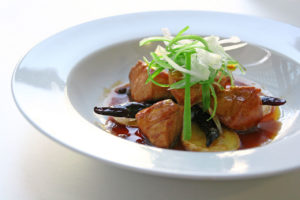 Between the 19th century and late 1960s, Chinese food in America was almost exclusively Cantonese in origin, more specifically, a rural version of Cantonese food brought to America by immigrants from the Toishanese countryside. Consequently, what was known to most 20th-century Americans as Chinese food was one very narrow representation of what people in China ate. This would be the equivalent of American food in China being rooted in the culture of 19th-century immigrants from Kern County.
Between the 19th century and late 1960s, Chinese food in America was almost exclusively Cantonese in origin, more specifically, a rural version of Cantonese food brought to America by immigrants from the Toishanese countryside. Consequently, what was known to most 20th-century Americans as Chinese food was one very narrow representation of what people in China ate. This would be the equivalent of American food in China being rooted in the culture of 19th-century immigrants from Kern County.
The primary reason for the dominance of rural Cantonese food in America was the Chinese Exclusion Act, passed in 1882. For more than 60 years, the Act made it illegal for almost every resident of China to immigrate to the United States. The majority of Chinese people were thus of Toishanese origin, as this was the group that had dominated pre-exclusion immigration from China to the United States. Even when exclusion ended symbolically in 1943, it did not end practically, as Chinese immigrants were restricted to a quota of 105 per year.
The repeal of the quota system in 1965 allowed new groups of Chinese people to immigrate to America, affecting the Chinese food scene. The bulk of newcomers was initially from Hong Kong and Taiwan because of unfriendly relations between the U.S. and mainland China. These new Chinese immigrants brought a modern update to Cantonese cuisine, which still dominated Chinese restaurants in America.
According to the Los Angeles Weekly, the only real effect that these new immigrants had on places such as Los Angeles’ Chinatown dining was their creation of new types of Americanized Chinese food, a faux version of Sichuan and Hunan cuisine that appealed to the local host population. New Chinese American favorites appeared, such as hot and sour soup, sizzling rice soup, kung pao chicken, General Tso’s chicken and mushu pork.
Authentic Chinese food from other regions of China was nonexistent in most Chinatowns even after immigration from Mainland China to the United States opened up. Americanized Cantonese food remained representative of Chinese cuisine. For places like the LA Chinatown, non-Cantonese food only began to appear in 2015, and now the Chinatown has three Chinese restaurants with different regional origins. Places like San Gabriel Valley, on the other hand, are extremely weighted toward non-Cantonese cuisine, because they became hotspots for many immigrants from mainland China in the 1990s.
LATEST STORIES
As a general trend, China restaurants in Chinatowns are shifting away from Cantonese cuisine and to more diverse cuisines from various regions in China.
AsAmNews is an all-volunteer effort of dedicated staff and interns. You can show your support by liking our Facebook page at www.facebook.com/asamnews, following us on Twitter, sharing our stories, interning or joining our staff.







